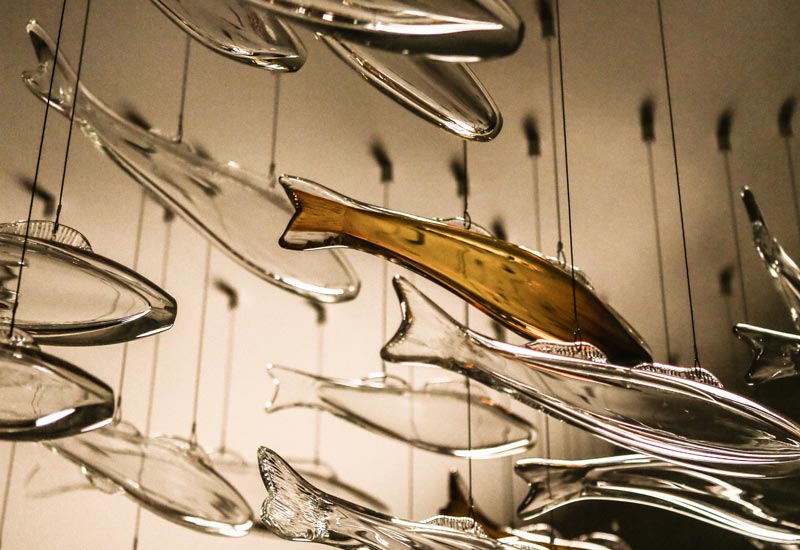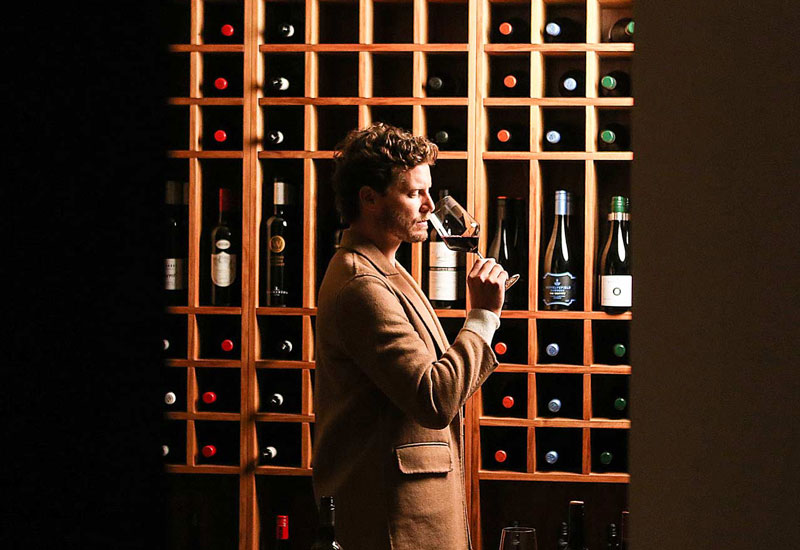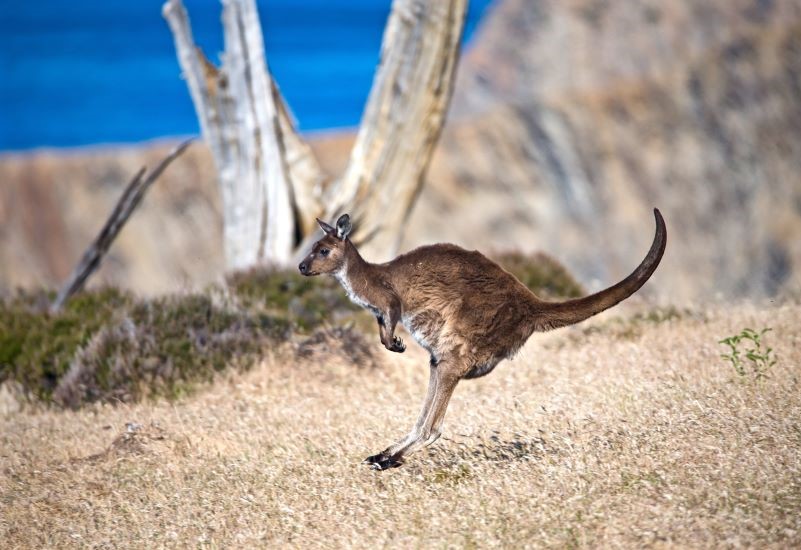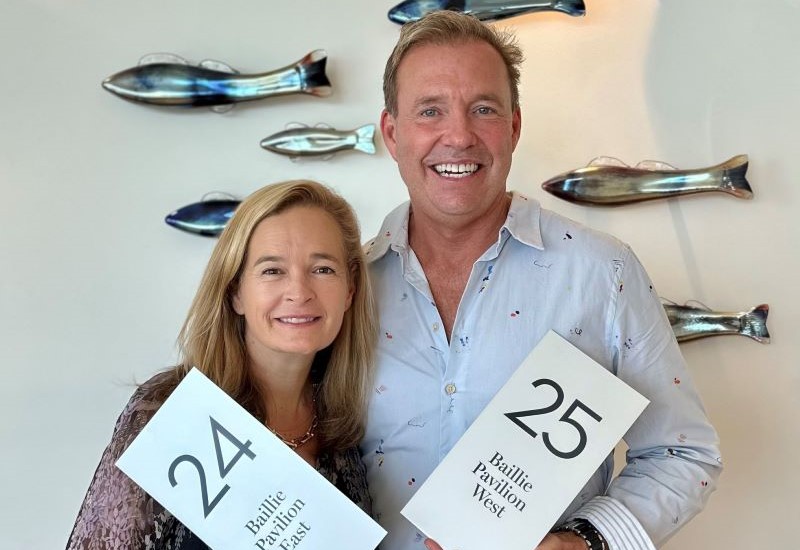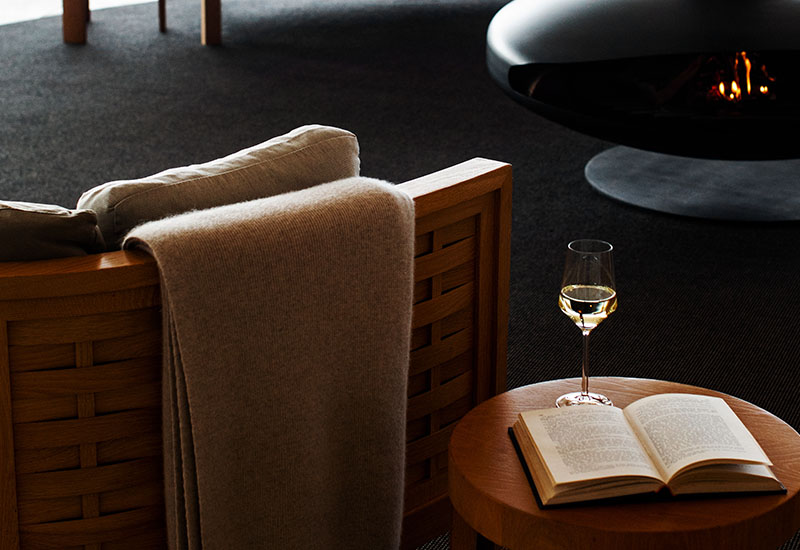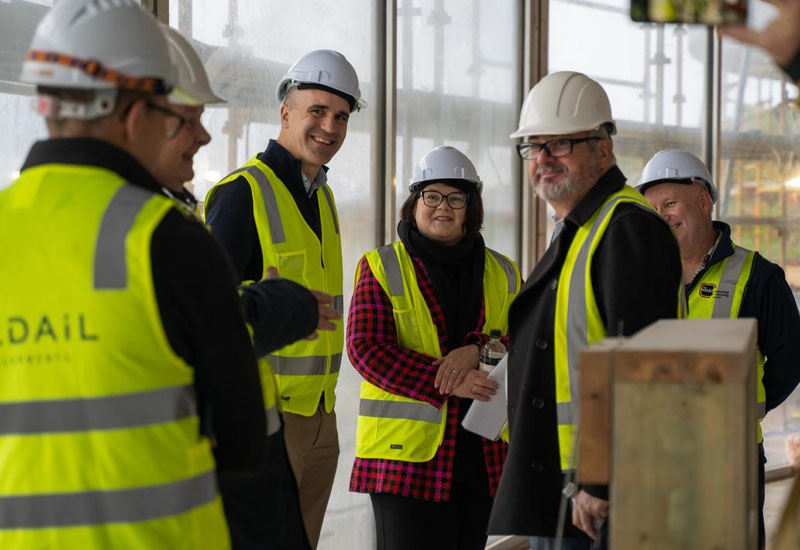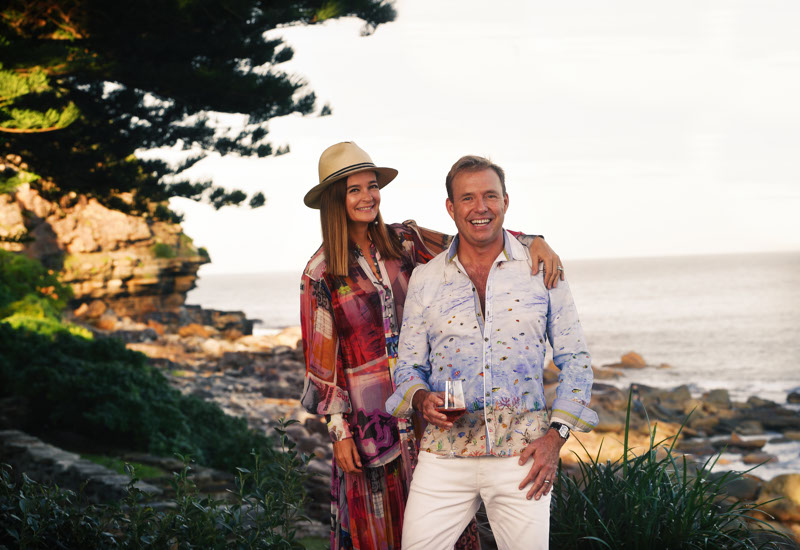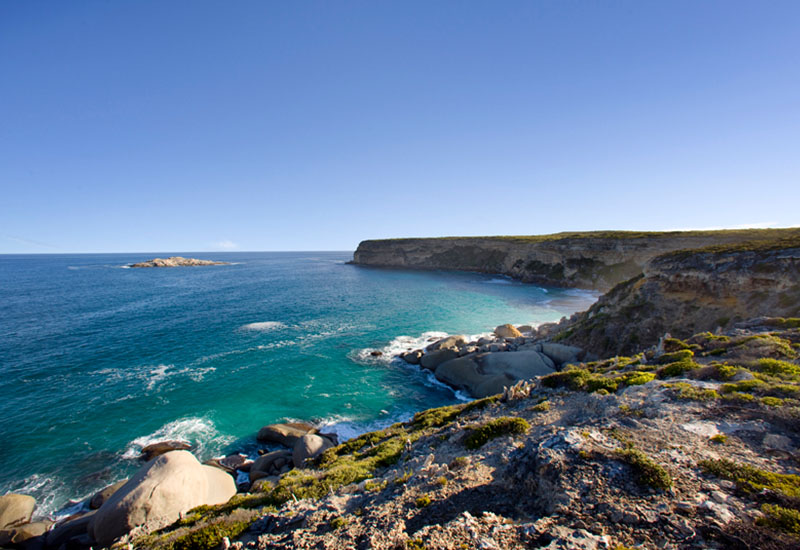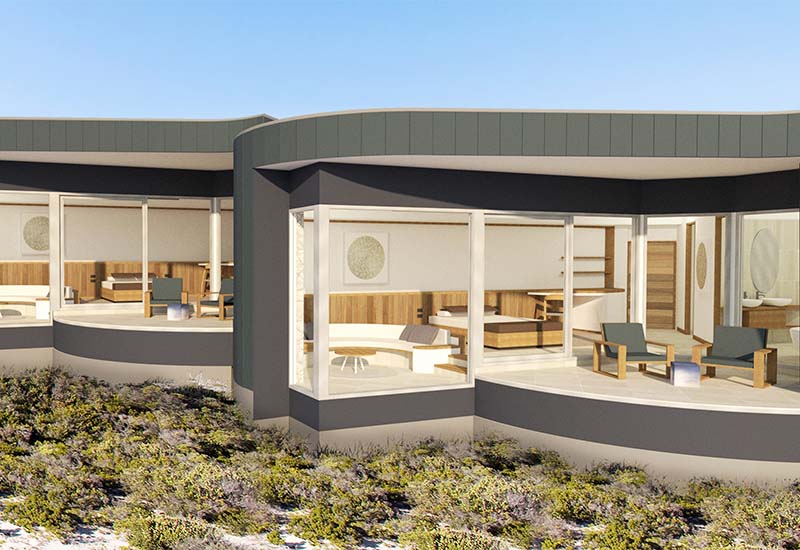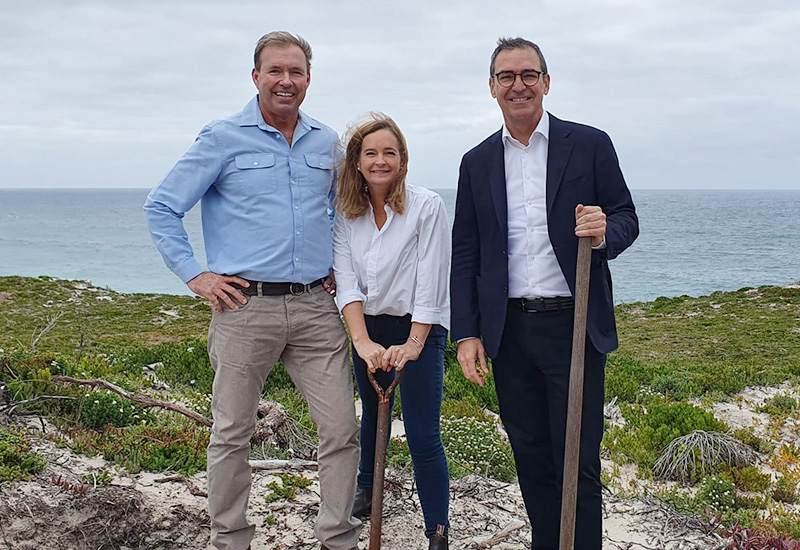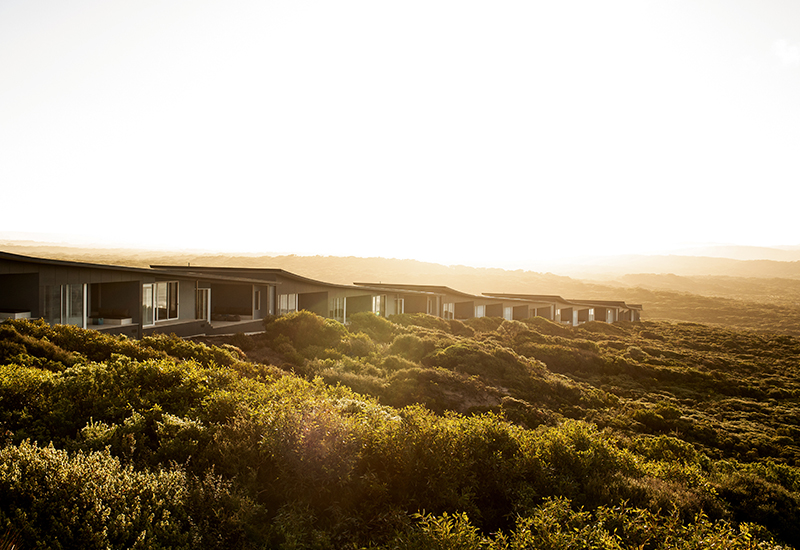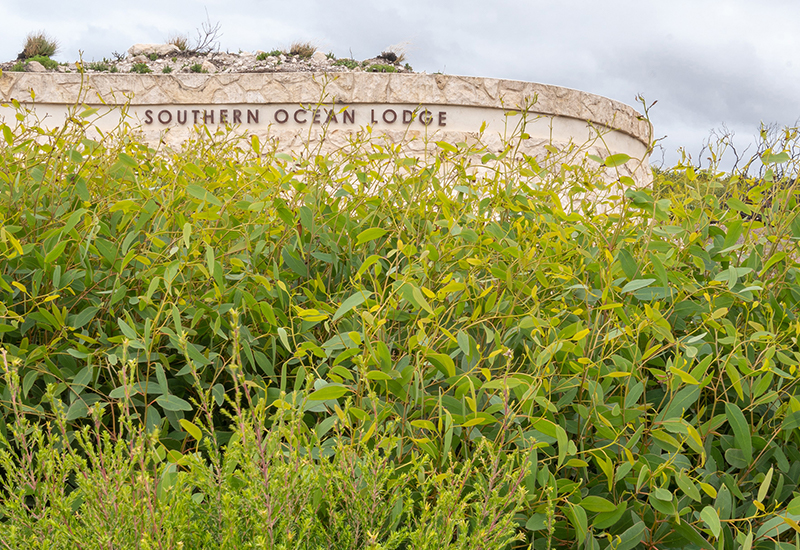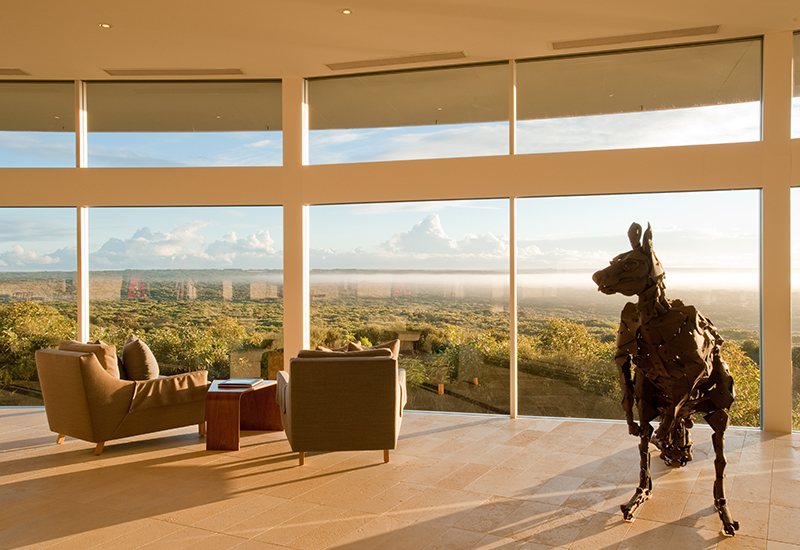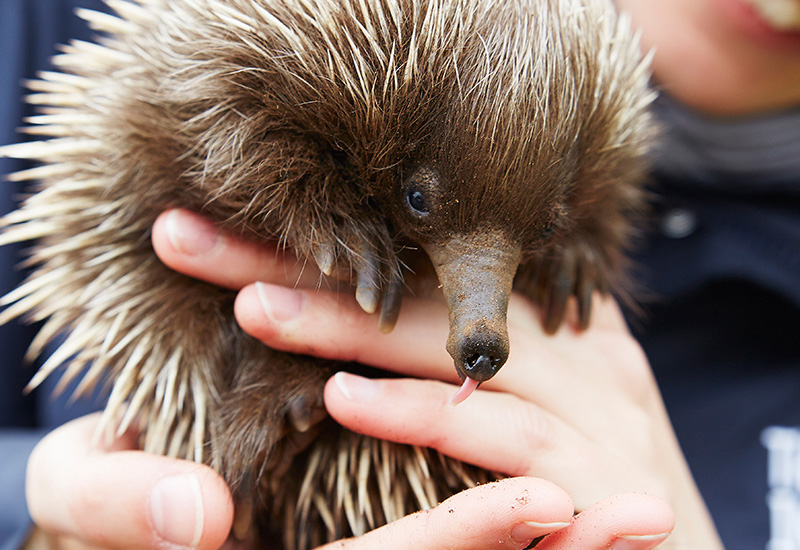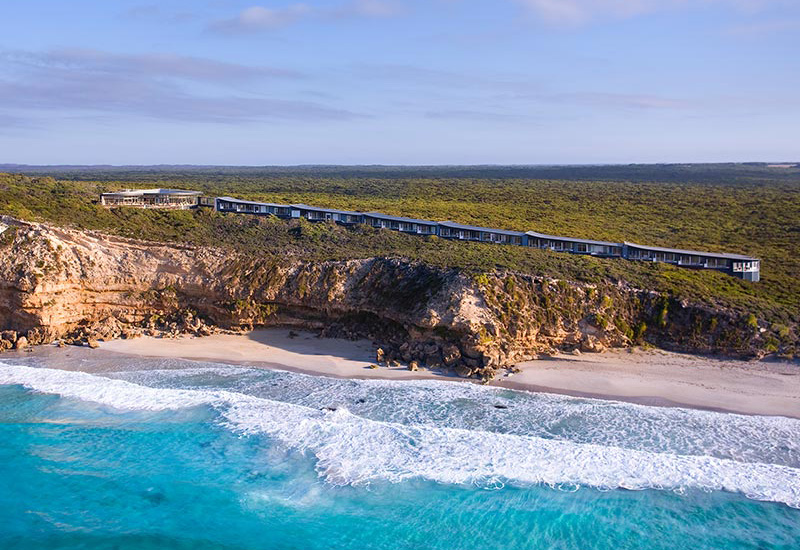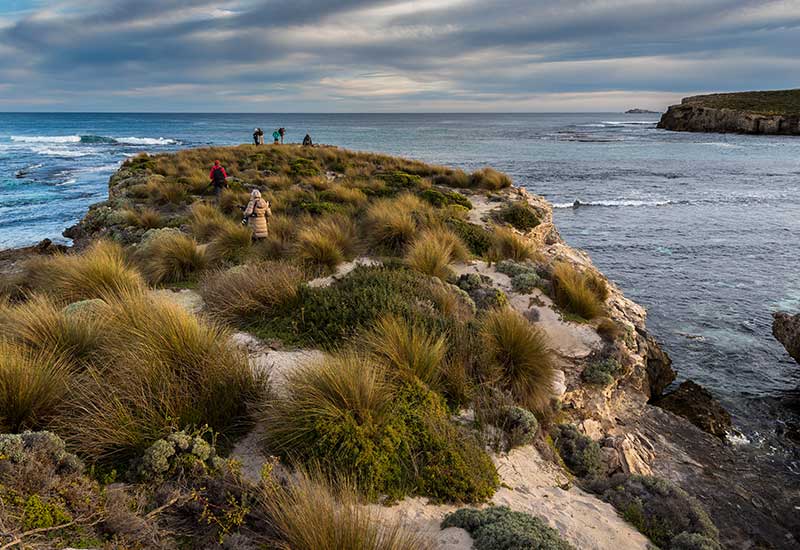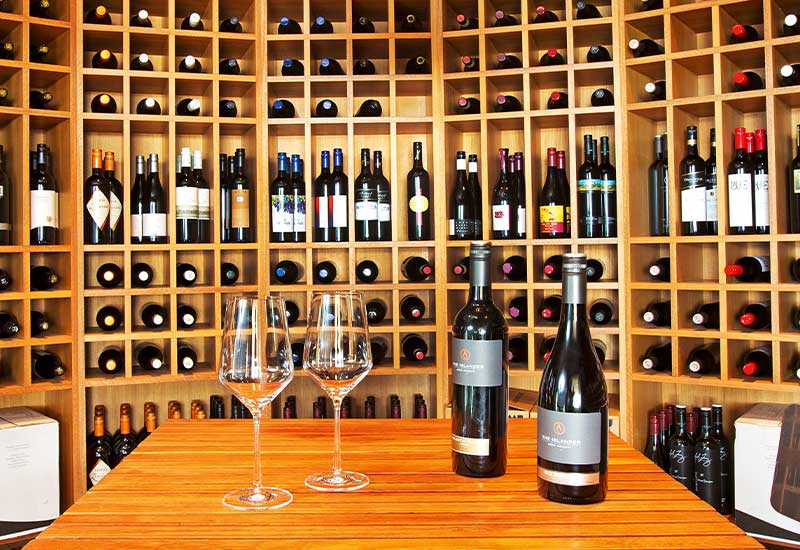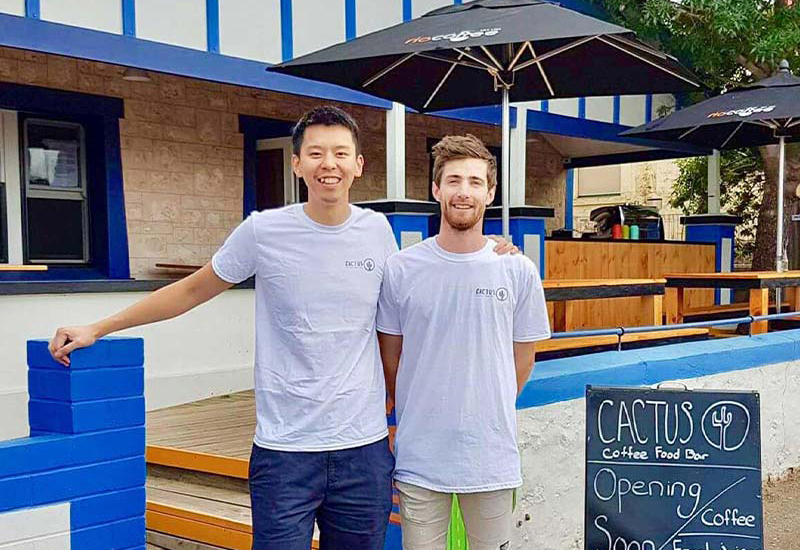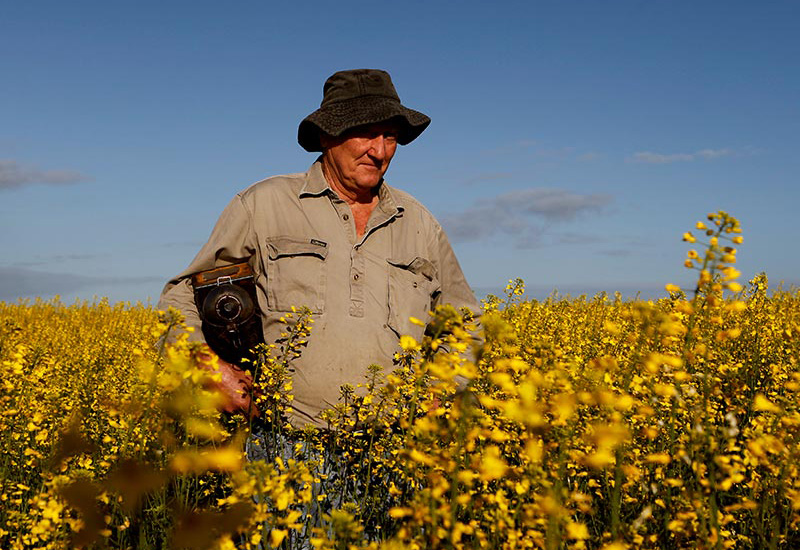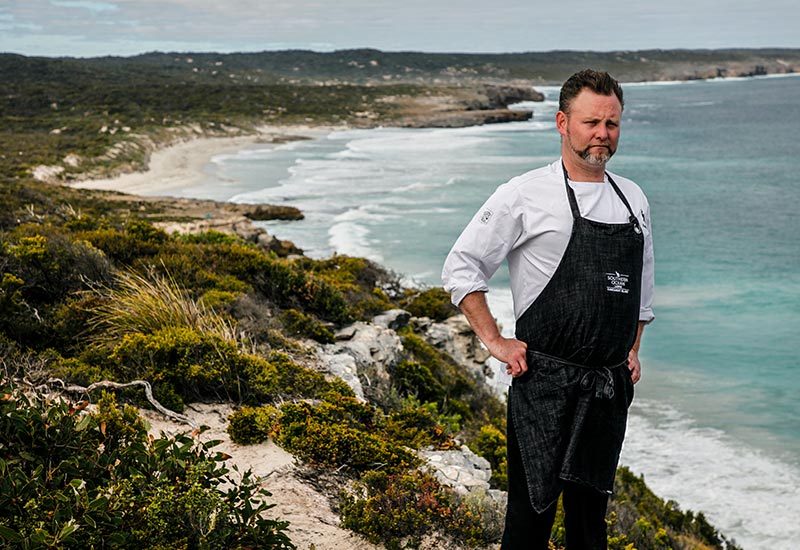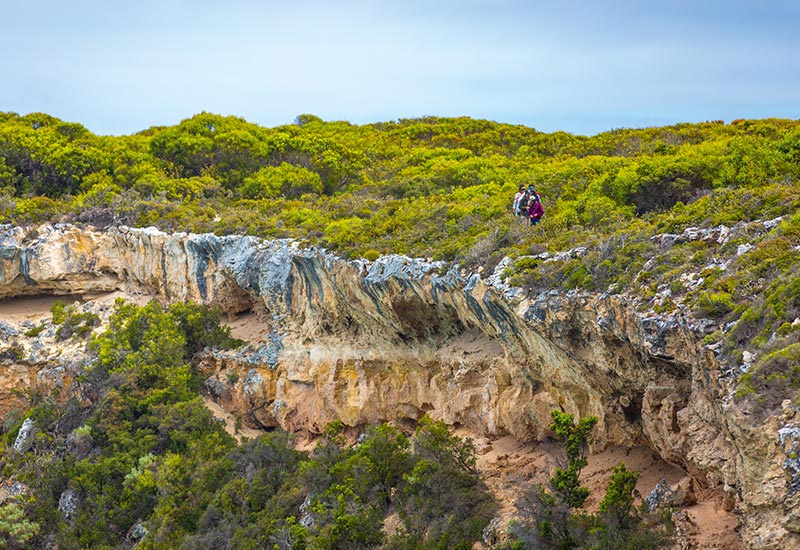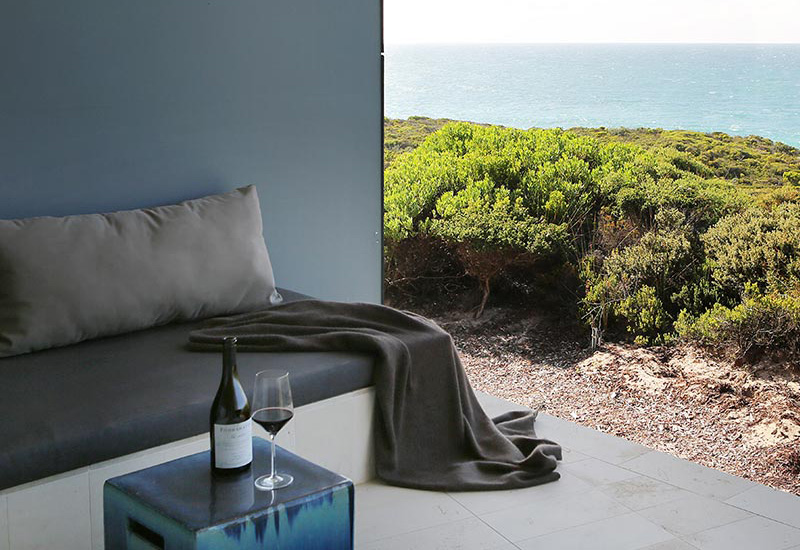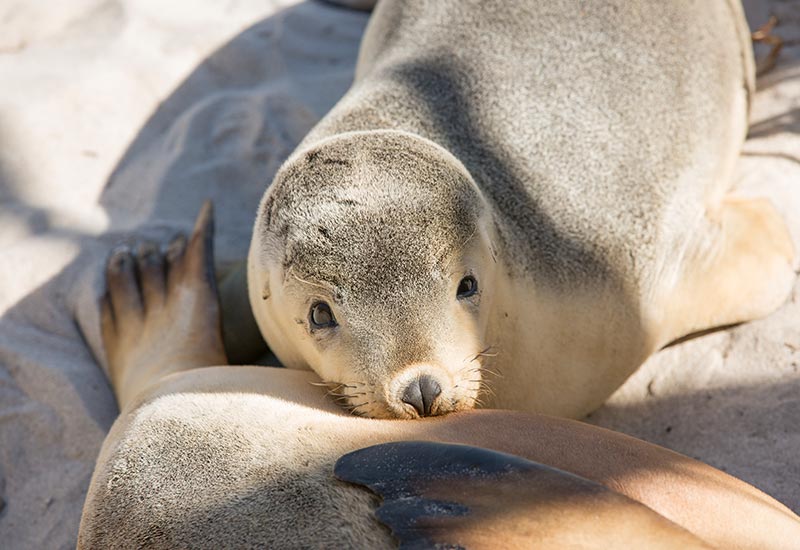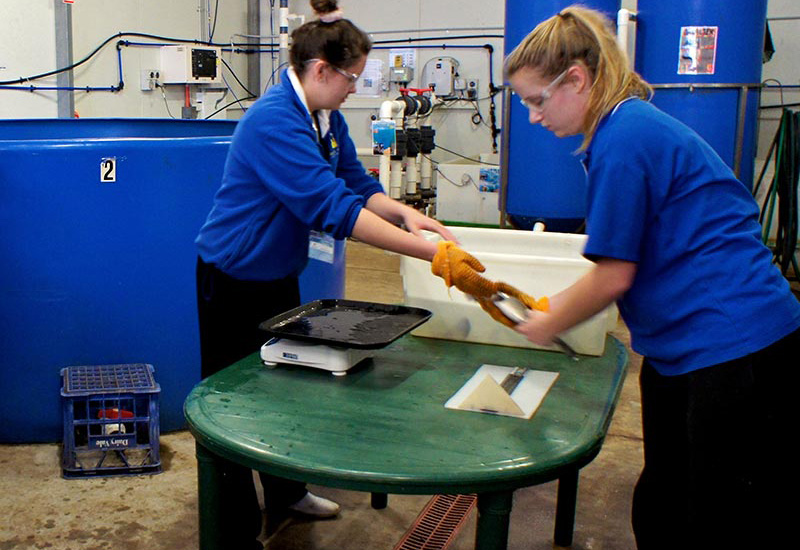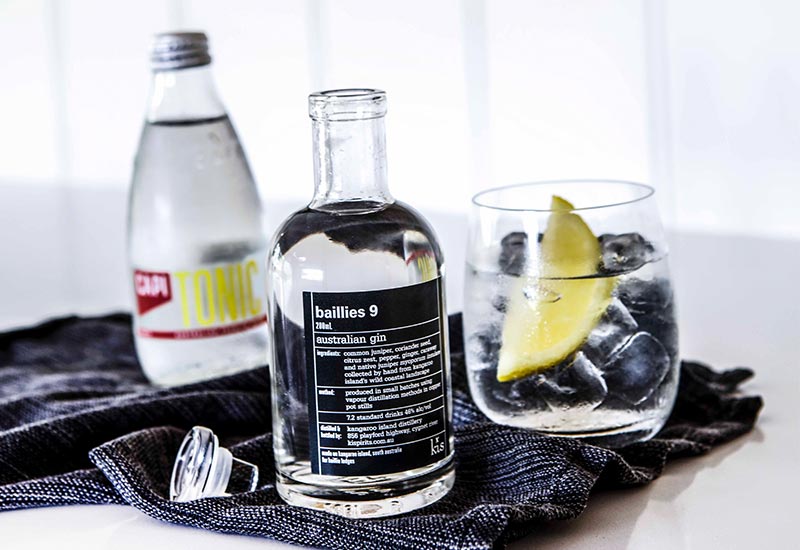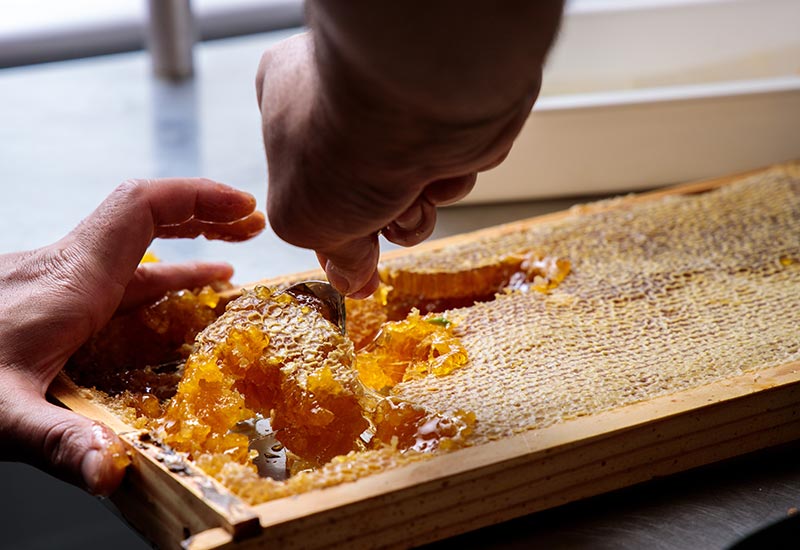FOR RESERVATION ENQUIRIES
CALL +61 2 9918 4355 OR ENQUIRE HERE
Journalist Roy Eccleston was one of the last writers to stay at Southern Ocean Lodge before it was destroyed in the summer fires of 2020. Roy was perfectly positioned to write the award-winning exclusive for SA Weekend Magazine shortly afterwards in January 2020. His piece was the joint winner in the SA Press Club 2020 Awards, New Corp Best Feature in Print or Digital.
Southern Ocean Lodge managers Alison Heath and John Hird huddled in a bunker as a nightmarish firestorm reduced the state’s finest resort to ashes. Now they tell their astonishing story.
It was after the firestorm swept over Southern Ocean Lodge for the fourth time that one of the staff decided it was time to leave the concrete bunker beneath the world-renowned Kangaroo Island hotel.
“We can go out now,” the man said, sure the danger must finally have passed.
But John Hird, the lodge’s general manager, was having none of it. “No, no – you’re staying for two hours,” he insisted, sticking to their fire plan. And just then, the inferno struck again.
“It roared five times,” says Hird, like he’s talking about a living thing. “It went over us five times. It didn’t just come at us from one angle, we were surrounded by it. It came at us from everywhere.”
It was after the third attack and about 50 minutes into the fire that Hird, in the smoky bunker with his wife and co-manager Alison Heath, and their four staff, began to hear things crashing down.
They had no idea what. But they knew that above them the $60 million luxury lodge – last year voted by Travel + Leisure magazine as the top hotel in Asia Pacific and the only Australian hotel to make the world top 100 list – would be lucky to survive. If it went, so would go the island’s pin-up hero for tourism. It only had 21 suites, and charged like a bull elephant, but the low slung design and the stunning views of the roaring Southern Ocean at Hanson Bay had made it an international tourism magnet that drew not just wealthy foreigners like Bill Gates, but spread the island’s image to all levels of travellers.
It was no surprise to Hird and Heath that on this day, Friday, January 3, they were in a bunker with a raging fire upon them.
They’d been waiting for the blaze, watching its progress, knowing from CFS briefings that it was coming. They stayed to switch on the lodge’s fire suppression system at the exact moment before the fire hit to maximise its impact. Hird figured the system had 50 minutes supply, and would handle any normal bushfire.
So the six-person crew of four men and two women sat in the bunker, below the hotel’s lobby, hoping that their plan would protect the lodge – and themselves.
But this was not a normal bushfire.
The first sign of trouble came on Monday, December 30, when lightning started fires in the Ravine des Casoars on the western edge of KI.
Heath recalls that arriving guests, being ferried by Mercedes-Benz from Kingscote in the east, couldn’t get through for much of the day because the CFS had closed roads to move its equipment around.
Hird was watching an array of apps, websites and satellite imagery, and judged the winds would be no problem for the next few days. But by Thursday, January 2, things had begun to shift.
The CFS held a briefing at Parndana, 60km away, at around 2pm. Hird and Heath explained their emergency plan to police – all the guests to go, and the bulk of the 50 staff to leave, except for those who would stay to try to protect the lodge. There were six, Hird explains, to allow four to carry a stretcher and one person to treat anyone who was injured.
The sprinkler system, which cost around $500,000, was designed to flood the surrounding vegetation, windows, roof and eaves. It had multiple pumps and supplies to cover the hotel and staff village. All up, it had around 750,000 litres of water.
The briefing from CFS incident controller Ian Tanner made clear they’d need all of that. The winds would change, and zigzag the fire west, south, east, and south again on a collision course with the lodge. “So we all knew,” says Heath. They also knew it would be unpredictable. Two of the CFS’s most experienced locals warned them they’d never seen anything like it fighting fires on KI for 40 or 50 years.
Hird called the lodge’s Sydney office to stop any new guests coming in. The lodge had been expecting a full house of 46 on January 3. Instead, it had just 13.
On Friday, the forecast was pushing 39C with shifting winds. At about 10.30am, Peter Davis of Island Beehive arrived to help if he could. His Ligurian bee honey was a staple at the lodge, and Davis had vast experience in the CFS. He and Hird went up to the resort’s spa, on a hill overlooking Hanson Bay with sprawling ocean views. But they weren’t looking south to the sea. To the west there was a fire in the Flinders Chase National Park. That wouldn’t be the problem, said Davis. The one to the north, which they could see, coming from the West End Highway area: that would be the trouble. Then Davis left to try to help his sons fight the fires.
Hird and Heath briefed the staff, and the guests. They planned to give them lunch and leave at 2pm, but a sudden switch in the alert status – from moderate to emergency with nothing in between – interrupted the meal and everyone was told to prepare to leave. That was at 1.30pm; by 1.45pm a convoy of 12 vehicles with staff and guests was bound for Kingscote.
Hird and Heath were as ready as they could be to defend a lodge they knew backwards. The pair had managed the place for owners James and Hayley Baillie – daughter of businessman Dick Smith – for eight years. They had never used the bunker or switched on the sprinklers in anger, but they had experience with crises and, at least publicly, project an unflappable, understated manner.
Hird, of Swiss and English parentage, had worked for Contiki, and helped evacuate guests from Bali after the second bombing in 2005. Heath, from the Adelaide Hills, had seen plenty of bushfires including the 1983 Ash Wednesday disaster.
Less than an hour after the guests had departed, the drama began in earnest. At 2.30pm the CFS called Hird with an urgent warning the fire was two minutes away, telling him to start the sprinklers. He did, but soon realised it was a false alarm, and ordered them off.
A ladder was organised, and Hird, who’d had heart surgery two months before, climbed on to a roof in the staff village, where, with a chair and bottles of water, he took on the role of fire lookout, scanning the horizon. By 3.30pm he could see the advancing wall of flame and smoke.
“It’s like 10 o’clock at night; it’s black,” he says. “The smoke moves like a curtain. And all of a sudden it moves to one side depending on the wind, and you’ll see a 100m wall of flame, and then the smoke comes back again and obliterates it completely. The strange phenomena is you’ve got a wall of fire in front of you and … the wind is coming from the north and it’s blowing that fire towards you, but in actual fact when you’re standing on the roof you feel the hot air blasting from behind, pieces of gum leaves and cold ash, flying at you from behind. And it’s because it’s creating its own winds. You’d think it was pushing the fire away, but it’s not; it’s being created by the fire.”
And then, at 3.45pm, hope arrived. A helicopter had been hovering above the lodge for a while; it turned out to be spotting for fire bombers. Suddenly, a 737 jet with 15,000 litres of fire retardant swooped from the clouds. Hird thought it would dump on the fire, still in the distance, but then the plane turned away and jettisoned its load away to the east.
Only later did he learn the retardant was meant for Southern Ocean Lodge, but downdrafts pushing the plane into the ground forced the pilot away.
Would it have made a difference?
“To be honest, after what I saw afterwards, no,” says Hird.
Next came three smaller bombers, soaking the mallee scrub that grew almost to the back doors of the lodge.
By now the fire was 4km away, but coming fast. To the east, at Kelly Hill Conservation Park, small puffs of smoke from debris flung forward from the front, were quickly turning into walls of flame.
“Everything is now black,” he says. “You can’t see. The whole horizon. The whole arc is just a wall of fire.”
It was time to get off the roof and start the sprinklers, a two-person job.
“I said, ‘I don’t know if it’s here yet or it isn’t … just slow the pressure down on the ground sprinklers we don’t want to use all the water’,” he recalls. “And as I said that I looked to the heavens and everything was first pitch black, and then two seconds later, everything went bright white and it was like this bright white cloud that was rolling into the heavens at 200km/h. And that’s when the embers started.”
The sprinklers started, they rushed for the bunker under the main lobby, flames coming at them sideways. Accessed from outside, it was a big space, but not tall enough to stand in most places, with a fire-resistant door and plenty of air. Heath had put chairs and some food in, and they were still feeling calm and confident they’d done what they could. Despite the conflagration engulfing the lodge, their mobile phones didn’t stop working.
While Hird and Heath watched the approaching firestorm, their bosses were holidaying at Lord Howe Island, 600km east of NSW, in the luxury lodge Capella that began their business Baillie Lodges in 2003.
James Baillie had been riding his bike when “a sixth sense” told him to go back to the lodge, where he found emergency messages waiting for him. Huddled around a phone in bright sunshine, they watched the incoming texts and images with shock.
“We were on holidays,” Hayley Baillie says, trying to describe how they felt as they sat in the sunshine, happy guests scattered around them oblivious to the disaster unfolding thousands of kilometres away. “Surreal. It’s very hard to describe. We felt helpless as well.”
But they were also hopeful. The KI guests were gone and there was a fire suppression system now working while their staff were in the bunker. And they’d seen blazes before.
In 2007, the bushfire that wiped out a lot of Flinders Chase National Park came within 4km of the lodge, not long before it was due to open. One worker, who tried to head home to his property, was killed.
Since then the lodge had become their flagship, even as they’d added other properties, from Uluru to the Daintree. The pair, who’d both worked in tourism before they met – James had run P&O’s Australian resorts and Hayley created experiential tourism experiences for international travellers – were proving to be trailblazers in the luxury lodge business in Australia.
Both from Sydney, they saw Kangaroo Island as a golden opportunity to set a new standard for luxury. The idea looked to be a huge risk. A lot of South Australians had never been to KI, so how likely would it be that people would travel from around the world to a remote spot on the edge of a cliff with nothing but the Southern Ocean between them and Antarctica – and each pay upwards of $1200 a day for the privilege?
“We’d done our homework,” says James. If a lot of Australians had never heard of KI, the Baillies knew that thanks to the work of devoted local tourism operators like Craig Wickham, of Exceptional Kangaroo Island, many Americans and Europeans knew about the place. “They’d pitched it as Australia’s Galapagos,” he says.
But the Baillies knew also that accommodation options on the island were limited – so the idea was to create a luxury eco-tourism property that appealed to both those who travelled the world loving to stay in luxury lodges, and those who wanted the environmental experience with nature trails and a vast array of wildlife from sea lions on the beach to koalas, seals, and kangaroos.
Originally shown the quieter north of KI, they chose a 100ha property next to Flinders Chase National Park at Hanson Bay on the wild south coast in 2002. But the site was only part of the puzzle. Thumbing through an architectural magazine, James saw the work of Adelaide architect Max Pritchard, who had been born on KI. They were taken by his work, and his island origins. Pritchard joined them at the property, and produced some initial concepts. The Baillies loved what they saw.
A lot of the things combined to make the lodge a favourite for the well-heeled. The suites were all beautiful with fine timber, limestone flooring, sea views and some had fireplaces. Just about everything was included. Guests mixed their own drinks, could grab wine from the cellar, dine on whatever they chose at the restaurant. And nature was at their doorstep, as the scrub surrounded the lodge and wildlife from sea lions to koalas and kangaroos were close.
But what really made the lodge’s reputation was Pritchard’s entry into the vast curved glass space the Baillies called the Great Room. The view was hidden as guests arrived. They walked a long entry path past a long limestone wall and then through big rusty doors – to be suddenly confronted with a massive curved space with the vast windows framing a panorama that extended from mallee scrub in the north to cliffs and beaches in the east, to white-capped ocean in the south.
The space looked big enough for a hotel catering for hundreds of people; the Lodge had, at most, around 50 guests, fewer than the staff.
Despite its success, there were nailbiting moments. There was the 2007 fire and then in 2008 the lodge opened at the height of the global financial crisis, a potential disaster given the emphasis on foreign tourists who make up half its guests. At the same time, some vocal locals didn’t like the fact it had been built on such a delicate site and worried about its environmental impact. But, say the Baillies, that’s not a complaint any more. Only 5 or 6 per cent of the lodge’s guests come from Adelaide, but the spin-offs for KI producers of everything from food and wine to art, has been huge.
“I don’t think anyone could argue the overall benefit we’ve had to the island,” James says, claiming the economic benefit from the resort would be about $10 million a year to KI. “But what’s priceless is the marketing,” he says. The lodge is promoted as an icon by the nation’s tourism authorities, a win for KI overall.
But there’s another side to that coin: what happens without the pull of the island’s biggest flag-bearer?
Earlier that Friday, the man who designed the lodge, Max Pritchard, was also worried fire could prove to be bigger trouble than he expected. The award-winning architect had grown up near D’Estrees Bay on the southeastern KI coast, and initially didn’t think the blaze could be a threat. “A fire has never travelled right across the island,” he recalls thinking. “Hopefully the wind will change and it will burn back on itself.”
But there was much about KI that was changing, Pritchard felt. When he was a boy, he didn’t remember many 40C days. It was the cold he recalled. These days the weather seemed to have changed.
Then a message from his older brother made him think that the fire might behave in ways nobody had ever seen before. Don Pritchard was a volunteer in the Adelaide Hills with the CFS and his unit had gone to KI to help. “Then on Friday I had a message from him,” Pritchard says. “He was driving one of two trucks defending the visitors’ centre at Flinders Chase (National Park). So that was completely gone. Those guys had to make a desperate run for it to get out of there. I had that message from him when he got out.”
And then he heard from the Baillies. “I knew through email they were in trouble. I knew they’d evacuated early on Friday, and I knew that they were well prepared – but I did have images as it was happening from staff there,” Pritchard says.
Perhaps naturally, as the man who designed the lodge, Pritchard wasn’t comfortable they were in the bunker. He wished they hadn’t stayed.
Inside the bunker, though, the mood was calm, says Heath. There were even some jokes. Some staff had brought in a few bottles of cold chardonnay, thinking Hird might like a glass, “and I was going, ‘Why didn’t you get the (rare and expensive) ’88 Hill of Grace!’,” he says.
The fire’s first pass lasted about six or seven minutes, and the sound was like a big fire roaring up a chimney “except 20 times as loud,” Hird says. Then it was quiet for a while, before another roar of about the same length. This time, the power went, and the lights went off. LED lights were switched on. Smoke filtered in, and they donned masks, wrapped wet towels around their faces. The door and its frame became hot, but there was no sign it was burning through.
All the time they were in contact – with the Baillies and staff at Kingscote. The fire came again three more times. Then, at 6.30pm, after two hours as was the plan, the door was cool so they opened it. Hird was stunned. “Outside, everything was white – a moonscape with black twigs sticking out.”
What had been a hillside of mallee was gone, covered in white ash, like a volcanic eruption. Much of the lodge still stood, but it was now burning badly. Hird knew he had to deliver some bad news to James Baillie. “I sent him a number of photos of the outside of it burning,” he says. “And I basically put in the message, ‘It’s gone’.”
Around that time, two of the male staff went outside; but when one ran around a corner, he slipped and lost his radio – and didn’t return. The other man, who came back to the bunker, was worried. Attempts to raise the missing man on the radio failed and his colleague wanted to go and find him, Hird says. “He kept saying, ‘I’ve got to go get him’ and I said ‘No, you don’t, it’s the last thing you do. If he’s gone, he’s gone. I don’t need you to be gone, too’.”
But he wasn’t gone. Instead, the missing man returned with a ute and fire trailer, and they all piled in to go to the staff village which, incredibly, was mostly untouched with its sprinklers still working. One door even had its Christmas wreath intact.
By this time they were again in contact with the CFS, which urged them to return to the bunker. But they declined, saying they felt safer where they were, since the bunker was now in a burning building.
From the staff village they watched the lodge die. Heath kept spirits up, joking of things they would not miss – like Doris, the electronic voice who would alert her night and day to any problem in the lodge. “We’ve lived with her a long time,” she laughs. “We’re very happy she’s passed.”
Several of the men also relaxed, grabbing beers from their rooms. Then at about 8.15pm, Hird says, the CFS sent a team to clear the road into the lodge, and help them leave. That evening, even as the lodge burned, the Baillies issued a statement insisting it would be rebuilt. “That was born out of the sheer emotion of what we put into it to start with,” James says. “It was a life’s work; Hayley and I selected every detail.”
“We know where everything comes from,” Hayley adds.
“Who we purchased it from. Who it was made by. We had the largest collection of KI artists anywhere.”
When James arrived to survey the ruins on Saturday, on a charter flight from Lord Howe, he found almost nothing had survived. There was Sunshine, the large kangaroo sculpture that stood in the main lobby, made from metal pieces of farm equipment; there was the suspended steel fireplace that hung in the centre of the Great Room, a piece of ceramic pottery, and some coffee cups. “Sunshine is a bit of a symbol of hope for the future,” Hayley says.
Like Hird, the Baillies think the sprinklers would have saved them in a “normal” fire. “This was an unprecedented firestorm that came from three sides,” says James. “It’s now been explained to us that it was what’s known as a pyroclastic cloud where the temperatures would have been in excess of 1000C. It’s similar to cremation, things are just to grey dust. The only place like that is in a volcanic eruption. It’s apocalyptic – it just vaporised.”
Rebuilding the lodge will take at least two years, say the Baillies, and cost up to $60 million. They have engaged Pritchard again, and the plan is to recreate the original design, mostly, allowing for a few tweaks and changes to building codes and better, more fireproof, materials.
But there’s a bigger question – can the lodge be rebuilt, safely, in such an environment? When the Baillies chose the site, they loved its wildness. But running an environmentally sensitive eco-tourism lodge in a changing environment comes with risks. Has it become too wild?
Crucially, can it be made safe enough to be insurable? They have insurance now, and expect that to be paid out for the full value of $60 million.
“The big issue, which doesn’t really seem to be being talked about, is what’s going to happen with insurance?” James says. “We’ve seen this a lot in Queensland over the last few years. Many hospitality and tourism operators are unable to get insurance (due to flooding and cyclones). Or, if they can get insurance, it’s having to be syndicated out of London out of Lloyds, and it’s unbelievably expensive.
“We had to walk away from an island acquisition in Queensland recently because the insurance was going to be over $2m a year. This is going to be an incredible issue moving forwards. Not just Kangaroo Island and South Australia – all of these places which are bushfire prone. You can’t afford to be spending one or two million dollars a year on insurance.”
And there’s no way he would rebuild without it. “Why would you go and spend $40-$50-$60m rebuilding something like Southern Ocean Lodge only to be able to lose it again?”
At the moment, he is hopeful. “It’s our intention to move ahead very, very quickly and start planning, rebuilding, recreating, and delivering Southern Ocean Lodge as an icon for South Australia,” he says. “That said, if we can’t place insurance … what if we are uninsurable?”
He flags a role for the State Government. “For something like Southern Ocean Lodge to rise from the ashes, how is that going to work? Is the SA Government going to back these iconic assets coming back? Is that part of the recovery plan?
“And what’s going to change in terms of bushfire management practices? Because the pendulum has to swing. The ability to do cool winter burns, have fire breaks, none of that is possible … it’s so complex under existing legislation.”
More broadly, though, national leadership and an international campaign to assure the world that Australia is not on fire and is taking climate change seriously, is crucial. “We need some national leadership we’re clearly not seeing,” Hayley says.
That Friday night, the CFS took the six from Southern Ocean Lodge to a safe area of well-burned ground and waited. Fires were raging across the island. So many people that day had lost their homes, their possessions, their life’s work. The destruction of the lodge was just one element of an ongoing disaster not only on KI but across the southeast of Australia.
Peter Davis, the honey man who’d dropped in to help Hird, later in the day watched his son’s home burn to the ground. Other tourism neighbours of the lodge lost everything. Farmers, foresters, homeowners, were all counting the cost of the inferno that crisscrossed their island like a hellish Pac-Man.
At the safe spot, Hird privately had a little cry: “You’re watching eight years of your life go up in smoke, and you’ve got the responsibility of 50 employees to tell them they don’t have a job anymore. And some have no possessions. And their cars burned. All horrible things.”
He and Heath will stay to help the Baillies rebuild. And Heath is relieved her main fear that day did not eventuate – that Hird’s heart, after the operation, might not cope.
“My heart rate is not supposed to go over 120 bpm in the first three months and I was clocking 150,” Hird admits. “But I took my tablets, I didn’t have a heart attack. I knew it was going to be a long day.”


